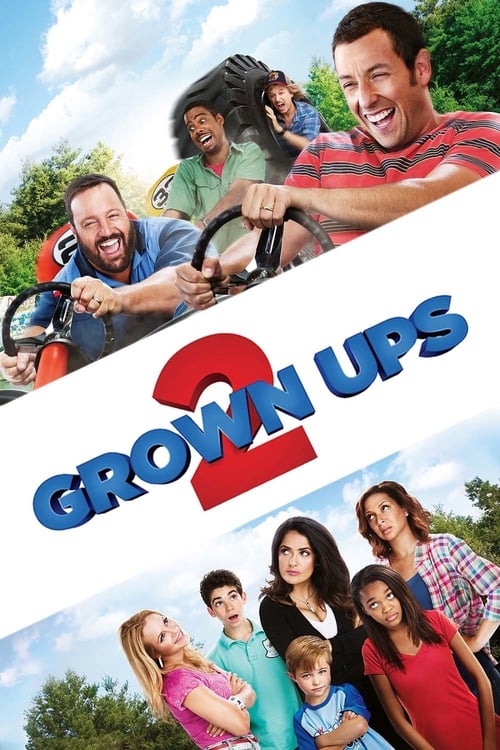Is Grown Ups 2 worth watching? A complete letdown in terms of story, characters, and plot flow. This sentiment echoes among fans who expected more from the sequel to Adam Sandler's original hit. As a follow-up to the first movie, Grown Ups 2 aimed to deliver humor and heart but instead delivered disappointment for many viewers. The film features familiar faces such as Kevin James, Chris Rock, and David Spade, yet it fails to captivate audiences with fresh content or engaging narratives.
Grown Ups 2 centers around Lenny Feder (Adam Sandler), a Hollywood talent agent who moves his family back to his hometown. Alongside his friends Eric Lamonsoff (Kevin James), Marcus Cobb (Chris Rock), and Rob Nickerson (David Spade), they navigate life challenges while dealing with personal issues. Despite its star-studded cast, critics argue that the movie lacks depth, relying heavily on slapstick comedy rather than character development. Moreover, some reviewers point out how Taylor Lautner surprisingly delivers one of the standout performances amidst an otherwise lackluster ensemble.
| Name | Adam Sandler |
|---|---|
| Born | September 8, 1966, Brooklyn, New York, United States |
| Profession | Actor, Comedian, Screenwriter, Film Producer |
| Known For | Waterboy, Billy Madison, Happy Gilmore, Punchline, Saturday Night Live |
| Awards | Nominated for Golden Globe Awards and several other accolades |
| Website | IMDb Profile |
The storyline introduces new elements early on, only to abandon them later without resolution. One example includes Lenny's struggle balancing his career aspirations against familial responsibilities. While intriguing at first glance, these themes never fully develop throughout the runtime. Instead, much of the screen time focuses on predictable jokes and repetitive gags that fail to resonate emotionally with viewers.
Director Dennis Dugan returns for this installment, hoping to recapture lightning in a bottle after directing both Waterboy and Happy Gilmore—two films considered classics within Sandler's repertoire. Unfortunately, Grown Ups 2 does not achieve similar success due largely to its reliance upon formulaic storytelling techniques. Many critics note that Sandler essentially plays himself again here, adhering closely to his established comedic persona rather than exploring new dimensions.
In addition to casting concerns regarding typecasting, there exists criticism concerning the inclusion of certain actors like Taylor Lautner whose presence seems gratuitous given their limited roles within the narrative structure. Although praised by some observers for delivering unexpected laughs during brief appearances, others question whether his involvement adds meaningful value overall.
Despite negative reviews from professional critics, box office numbers indicate substantial public interest. Released theatrically in July 2013, Grown Ups 2 grossed over $140 million worldwide against a production budget estimated around $70 million. Such financial performance suggests either widespread appeal despite critical disdain or perhaps indifference towards quality considerations amongst mainstream audiences seeking light entertainment options.
One aspect deserving acknowledgment involves visual effects utilized effectively within specific scenes involving animals—a recurring motif throughout the franchise. These sequences showcase technical proficiency even if overshadowed by weak writing choices elsewhere. Nevertheless, they provide fleeting moments of amusement amid otherwise uninspired material.
Ultimately, opinions vary widely depending upon individual tastes regarding humor styles and expectations set prior to viewing. For those nostalgic about previous entries featuring similar tones, Grown Ups 2 might serve adequately as casual viewing fare. However, newcomers unfamiliar with earlier works may find little reason to invest time exploring further beyond superficial layers presented.
Believe it or not, Adam Sandler has never been in a sequel before—not until Grown Ups 2 came along. It only feels like he constantly repeats himself because his movies tend toward uniformity. He portrays someone resembling himself, surrounded by real-life pals playing supporting roles—all crafted under scripts penned alongside producers sharing comparable sensibilities. Thus emerges another entry mirroring past efforts without venturing into uncharted territory creatively speaking.
Let us delve deeper into what makes Grown Ups 2 distinct compared to other projects helmed by Sandler. Unlike standalone productions boasting unique premises, this particular endeavor operates strictly as continuation capitalizing off preexisting fanbases cultivated through initial installments. Consequently, any innovations attempted likely face scrutiny measured against established benchmarks already set high thanks to preceding successes.
Furthermore, examining cultural contexts surrounding release timing offers additional perspective. By 2013, comedic trends had begun shifting away somewhat from broad physical antics characteristic of Sandler's oeuvre toward sharper satirical approaches gaining traction elsewhere within media landscapes. Therefore, timing also played significant role influencing reception patterns observed post-premiere events.
Regardless of external factors impacting perception, internal consistency remains paramount when assessing artistic merit. Regrettably, Grown Ups 2 stumbles repeatedly failing maintain coherence across multiple levels—from dialogue exchanges lacking wit to situational setups falling flat predictably. Even loyal followers accustomed tolerating occasional missteps might grow weary encountering repeated offenses compounded episode after episode.
Interestingly enough, despite overwhelming negativity expressed publicly via various channels, dedicated supporters continue defending merits perceived worthy celebrating regardless detractors' perspectives. Such dichotomy highlights complexities inherent evaluating popular culture products where subjective interpretations often clash producing polarized reactions reflective broader societal divisions existing today.
As conclusion drawn nears consideration final thoughts becomes necessary addressing implications moving forward particularly relevant considering ongoing relevance maintained franchises similar nature persisting contemporary cinema environment characterized rapid change driven technological advancements reshaping traditional paradigms previously governing industry standards altogether.
Therefore, understanding reasons behind sustained demand despite acknowledged shortcomings necessitates exploration beyond surface level analysis typically employed quick judgment calls hastily rendered uninformed spectators merely glancing headlines without investing effort comprehending underlying dynamics truly driving phenomena observed unfoldings screens everywhere continuously evolving world ever-changing tastes preferences shaping collective consciousness humanity itself.



